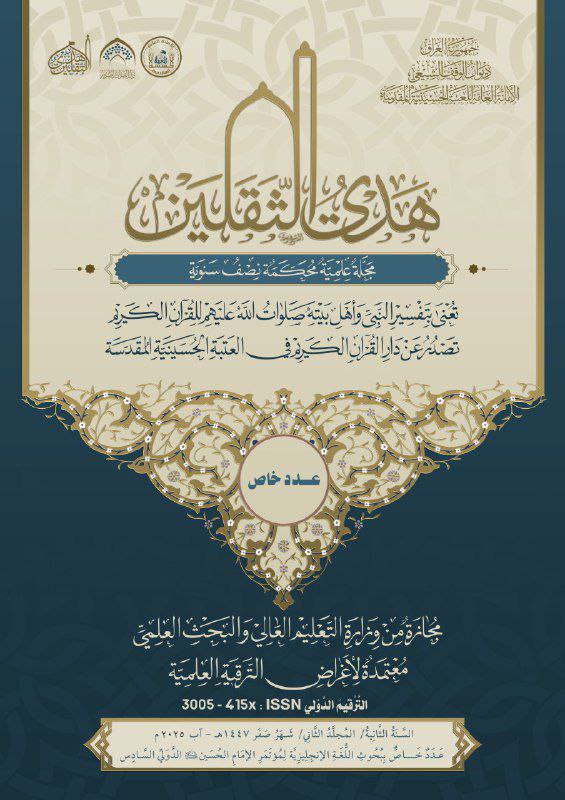Abstract
Abstract:
The study addresses the concept of social rehabilitation in Imam Ali’s (AS) Nahj Al-Balagha. It adopts a rhetorical-linguistic approach, in particular the rhetorical persuasion theory, to examine the reflections of the teachings of the Holy Quran and the Prophet traditions in the Imam’s approach for social rehabilitation. To achieve this objective, the study utilizes the content analysis method to highlight the linguistic and rhetorical devices which made Imam Ali’s discourse highly influential in providing advice for social rehabilitation in his will to his son Imam Hasan (AS). Hence, data for analysis are mostly collated from this will in addition to other excerpts in Nahj Al-Balagha. The most important findings of the study indicate that Imam Ali adopts an educational intimate approach for social rehabilitation. This has been reflected in his unique selection of words which have been very fruitful in this regard. The analysis has shown that Imam Ali (AS) has utilized various linguistic and rhetorical devices in this will. The most commonly used linguistic devices include emphasis, praise and dispraise, imperatives, prohibitions and warnings, and vocatives, whereas the rhetorical derives include simile, metaphor, antithesis, and quotations. It can be concluded that Imam Ali’s approach for social rehabilitation reflects his accurate understanding of the teachings of the Holy Quran and the Prophet traditions, and that his approach should be adopted in educational institutions for pedagogical purposes.
The study addresses the concept of social rehabilitation in Imam Ali’s (AS) Nahj Al-Balagha. It adopts a rhetorical-linguistic approach, in particular the rhetorical persuasion theory, to examine the reflections of the teachings of the Holy Quran and the Prophet traditions in the Imam’s approach for social rehabilitation. To achieve this objective, the study utilizes the content analysis method to highlight the linguistic and rhetorical devices which made Imam Ali’s discourse highly influential in providing advice for social rehabilitation in his will to his son Imam Hasan (AS). Hence, data for analysis are mostly collated from this will in addition to other excerpts in Nahj Al-Balagha. The most important findings of the study indicate that Imam Ali adopts an educational intimate approach for social rehabilitation. This has been reflected in his unique selection of words which have been very fruitful in this regard. The analysis has shown that Imam Ali (AS) has utilized various linguistic and rhetorical devices in this will. The most commonly used linguistic devices include emphasis, praise and dispraise, imperatives, prohibitions and warnings, and vocatives, whereas the rhetorical derives include simile, metaphor, antithesis, and quotations. It can be concluded that Imam Ali’s approach for social rehabilitation reflects his accurate understanding of the teachings of the Holy Quran and the Prophet traditions, and that his approach should be adopted in educational institutions for pedagogical purposes.
Keywords
Imam Ali.
Keywords: rhetorics
Nahj Al-Balagha
Social Rehabilitation
Will
Abstract
الملخص:
تتناول الدراسة مفهوم التربية الاجتماعية في نهج البلاغة للإمام علي (ع)، وتعتمد الدراسة على المنهج البلاغي اللغوي، وبخاصة نظرية الإقناع البلاغي، لدراسة انعكاس تعاليم القرآن الكريم والأحاديث النبوية الشريفة في نهج الإمام في التربية الاجتماعية. ولتحقيق هذا الهدف، تستخدم الدراسة أسلوب تحليل المحتوى لتسليط الضوء على الوسائل اللغوية والبلاغية التي جعلت خطاب الإمام علي مؤثراً للغاية في تقديم المشورة في التربية الاجتماعية في وصيته لابنه الإمام الحسن (ع). وتم جمع بيانات التحليل مستمدة في معظمها من هذه الوصية بالإضافة إلى مقتطفات أخرى من كتاب نهج البلاغة. وتشير أهم نتائج الدراسة إلى أن الإمام علي (ع) يتبنى نهجاً تربوياً حميماً في التربية الاجتماعية، وقد انعكس ذلك في اختياره الفريد للألفاظ التي كانت مثمرة للغاية في هذا الصدد. وقد أظهر التحليل أن الإمام علي (ع) استخدم وسائل لغوية وبلاغية مختلفة في هذه الوصية. ومن أكثر الوسائل اللغوية استعمالاً هي التوكيد والمدح والذم والأمر والنهي والتحذير والنداء، أما الأساليب البلاغية فتشمل التشبيه والاستعارة والتضاد والاقتباس. ومن هنا يمكن الاستنتاج أن منهج الإمام علي في التربية الاجتماعية يعكس فهمه الدقيق لتعاليم القرآن الكريم والأحاديث النبوية الشريفة، وأن منهجه ينبغي اعتماده في المؤسسات التعليمية لأغراض تربوية.
تتناول الدراسة مفهوم التربية الاجتماعية في نهج البلاغة للإمام علي (ع)، وتعتمد الدراسة على المنهج البلاغي اللغوي، وبخاصة نظرية الإقناع البلاغي، لدراسة انعكاس تعاليم القرآن الكريم والأحاديث النبوية الشريفة في نهج الإمام في التربية الاجتماعية. ولتحقيق هذا الهدف، تستخدم الدراسة أسلوب تحليل المحتوى لتسليط الضوء على الوسائل اللغوية والبلاغية التي جعلت خطاب الإمام علي مؤثراً للغاية في تقديم المشورة في التربية الاجتماعية في وصيته لابنه الإمام الحسن (ع). وتم جمع بيانات التحليل مستمدة في معظمها من هذه الوصية بالإضافة إلى مقتطفات أخرى من كتاب نهج البلاغة. وتشير أهم نتائج الدراسة إلى أن الإمام علي (ع) يتبنى نهجاً تربوياً حميماً في التربية الاجتماعية، وقد انعكس ذلك في اختياره الفريد للألفاظ التي كانت مثمرة للغاية في هذا الصدد. وقد أظهر التحليل أن الإمام علي (ع) استخدم وسائل لغوية وبلاغية مختلفة في هذه الوصية. ومن أكثر الوسائل اللغوية استعمالاً هي التوكيد والمدح والذم والأمر والنهي والتحذير والنداء، أما الأساليب البلاغية فتشمل التشبيه والاستعارة والتضاد والاقتباس. ومن هنا يمكن الاستنتاج أن منهج الإمام علي في التربية الاجتماعية يعكس فهمه الدقيق لتعاليم القرآن الكريم والأحاديث النبوية الشريفة، وأن منهجه ينبغي اعتماده في المؤسسات التعليمية لأغراض تربوية.
Keywords
الكلمات المفتاحية: البلاغة، التربية الاجتماعية ، الوصية، نهج البلاغة، الإمام علي (عليه السلام)
